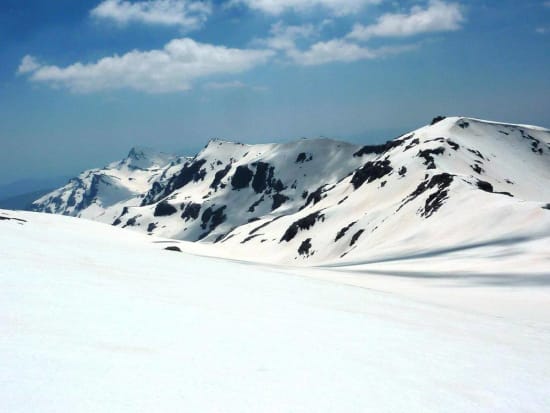In March 1867 he read his report before the Alpine Club and its magazine, The Alpine Journal, was then published in full. This included a basic map, which just marked the most important peaks, rivers and major towns of La Alpujarra.
Thanks to Pepe Badaje for digging out this information and providing the video with old photos. Read his report in spanish on his blog.

The distant Cerro de Caballo from Elorrieta June 2010
He intended to go from Granada to the peak of Veleta and then descend to Lanjaron, but could not find any guide in the city who was willing to accompany him on foot. So he decided to travel by stagecoach from Granada and changed plans to start from Lanjarón.
In Lanjarón, he found Juan Estévez, a young, strong-willed, strong, active, fearless local man, willing to walk all the hours that were needed. His lack of knowledge of the Sierra Nevada made up by enthusiasm and effort.
From Lanjarón they climbed the Cerro de Caballo, a climb that served to convince the Englishman that unfortunately he had underestimated the Sierra Nevada. I might point out that one and a half centuries later this is still being done on a regular basis! They dropped down to the Laguna de Caballo, whose slopes still had a respectable amount of snow and returned to Lanjaron.
The second climb was performed from Capileira, where they were joined by another local guide. From here they made the very long climb to Mulhacén. Ormsby was quite impressed and said.... "the Pyrenees or the Alps have nothing to be compared properly with it."
In his third outing, he started out again from Lanjaron, camped high overnight near the Cerro del Caballo and restarted before dawn taking the track leading to what is now the Elorietta refugio.
At one point along the way, probably the ridge of Tajos de la Virgin, he had to overcome a large snow slope, "so hard that nothing could pierce the surface". They reached the Col de Capileira/Cariguela, the highest pass in Europe used for genuine commercial purposes. The ascent of Veleta was made from here. Once on the summit of Veleta they said their goodbyes, Ormsby moving north to Granada and the _"cañonero", Juan Estévez, _returning to Lanjarón.
Viajeros ilustres: Primer viaje de Ormsby a... by pepebadaje
Here is the report by John Ormsby on Lanjarón and Juan Estévez, the guide found in the village and who was his companion during his stay in Sierra Nevada:

Lanjaron street in 1958
Lanjarón is one of the most beautiful places I have been fortunate to see on my walks through the deserts of this world ...
The town is a long street of white houses with low roofs, and like all people of Las Alpujarras , is quite Moorish in appearance. It perches on the south side of a steep mountain, with a deep ravine in front, and the narrow ledge on which it sits is a maze of pomegranate and peach, fig and orange trees. But we are not here to talk about oranges, except perhaps to note that Lanjarón oranges are famous throughout the south of Spain, and are a wonderful provision of nature that comforts the mountaineer in a hot and dry land.
Among the attractions of the area which are relevant here - a rarity in Spain, and doubly rare in this area, a clean and comfortable small inn and a very efficient guide. The driver of the coach, who was interested enough in my way of proceeding, said he thought he knew a young man who would serve my purposes, and the young man, as later proved, responded reasonably well. In the event that any member of the Alpine Club was once in Lanjarón, his name is Juan Estévez. He is a very willful young man, with pretty good humor, strong, active, ready to walk all the hours it takes, not afraid of anything and is rather fond of outdoor camping.
He now knows the mountains very well, and also the way to reach most major sights, but I can not say much about what he knew before we started. The main flaw I find in him was his habit of shouting in order to become better understood. No European language easier to understand than the Spanish after a little practice, where the Castilian standard, a thoughtful language in which to pronounce each vowel and consonant as written. But the Andalusian is a corruption of the Castilian, not pronouncing certain letters, slurring other and speaking very fast.
The dialect of the Alpujarras, is a corruption of the Andalusian. However, I understood better than I had expected. On the afternoon of our third day he told the innkeeper that he could understand what I was saying. If we started that night, he said, could reach the Veleta and return the next afternoon, and well, a little after midnight we began to ascend in a straight line behind Lanjarón
The following summer, 1867, the Sierra Nevada hosted another English expedition made by Charles Packe, a Mr. Byles, and Henri Passet guide in that journey Lanjarón located in Juan Estévez thanks in the main to the story's first trip Ormsby.
